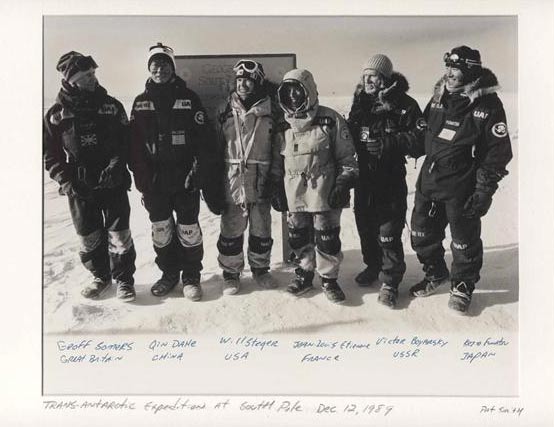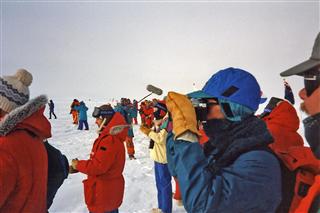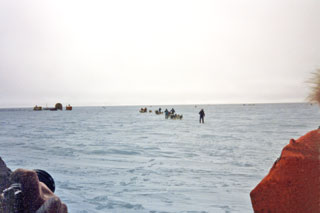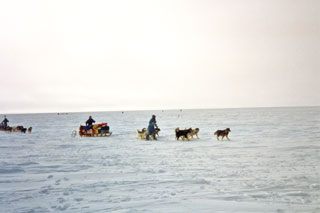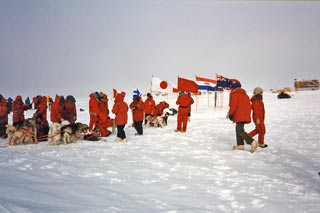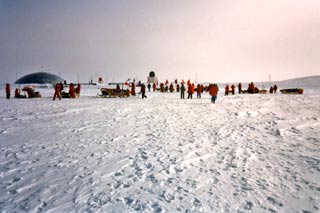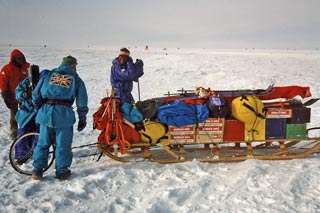The International Trans-Antarctica Expedition
1989-1990
|
This was one of those really unique Antarctic ventures. 6 men crossed Antarctica the long way...starting at the very tip of the Antarctic Peninsula on 27 July 1989...passing through the abandoned Siple Station, the ANI camp at Patriot Hills, South Pole, Vostok, and several other Russian (Soviet) stations ending at Mirnyy on 3 March 1990--220 days and over 3700 miles. 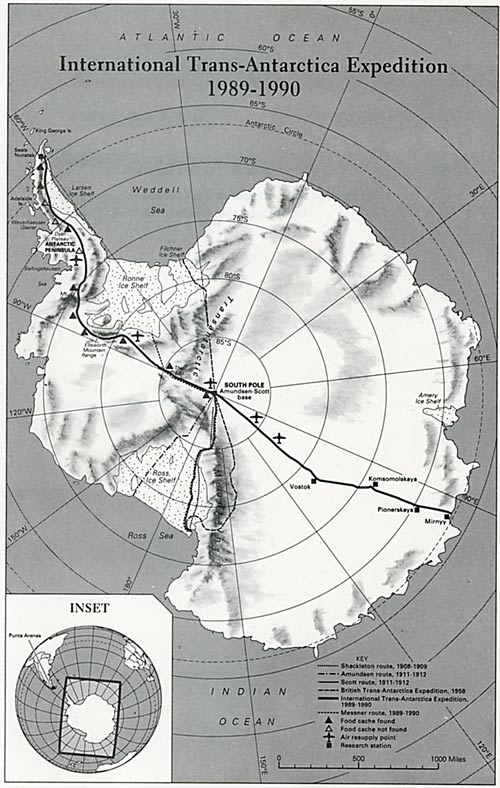
The venture had been conceived by leader Will Steger of Minnesota during his previous North Pole trips...the rest of the international group included Jean-Louis Etienne, a French doctor and explorer who amazingly had met up with Will in the midst of their separate North Pole treks; Victor Boyarsky, a Russian scientist with previous Antarctic experience collecting weather data; Keizo Funatsu, a dog trainer from Osaka, Japan; Quin Dahe, a Chinese glaciologist, and Geoff Somers, a BAS veteran and dog trainer who served as the group's navigator. After the obvious long period of organizing, planning, training and fundraising, the team was flown to King George Island by a Russian military Ilyushin-76 aircraft...and from there they were flown to their starting point by an Adventure Network (ANI) Twin Otter. The starting point was the Seal Nunataks (65°S 60°W; named the Seals Nunatak in the expedition documentation) near the tip of the Antarctic Peninsula. Thus...they started in a rarely traveled section of Antarctica in the middle of the winter. The first part of the trip was plagued by darkness, cold, storms, and crevasses. Their food and supplies had been cached the previous season, and they were unable to find some of the caches due to deep snow...so they ended up needing some extra resupplies by air. The group eventually found improving weather and traveling conditions as they climbed toward the Ellsworth Mountains and the Antarctic Plateau. They reached Siple Station on 21 October--this base had been abandoned early in the 1987-88 season, and the 26-mile VLF antenna was almost buried--the wire was just above the snow surface. The permanent station was of course completely buried and invisible, but the group did explore the summer camp head module, still well stocked with reading material. The next station stop--Patriot Hills, which they reached on 8 November, was inhabited and a bit more welcoming. They had some cooked camp food, replenished supplies and some of their dogs, met up with Reinhold Messner, and negotiated with ANI about their air support. From here to Pole much of their non-travel time would be spent on the radio trying to confirm arrangements for fuel supplies at Pole...vital for the necessary air support (the team was supported by ANI Twin Otters for the first part of the trip until they reached Vostok; from there their resupply caches had been carried by the Russian tractor teams). Reinhold Messner was experiencing similar difficulties arranging air support for his Antarctic crossing to McMurdo. Eventually, perhaps with the assistance of Arthur Chilingarov, their primary Russian government benefactor in Moscow, the Russians agreed to provide assistance in getting fuel delivered to Pole (Chilingarov had long-time involvement with the Russian Antarctic program...perhaps most notably (for Polies) for his strange aircraft venture to Pole in January 2002.) Initially the fuel was to be airdropped, actually the twelve tons was landed. Thus the International Trans-Antarctica Expedition also became the "Soviet Antarctic Expedition." This suddenly changed the NSF attitude...as Moscow asked NSF to officially greet Victor as the "diplomat," and official and unofficial radio communication with Pole was established as the expedition neared 90°S. And so the stage was set...and the expedition approached the dome at the end of their travel day (on Chilean time) on 11 December...as we stood outside the station on our morning of 12 December: | |
|
After the initial confusion and flurry of arrival, the team gathered at the geographic Pole for official and unofficial photographs, including the one at the top of this page...and this photo of mine. This photo features the six members of the traverse team (in the same order as in the main photo...and also the two Saudi scientists from the University of Jeddah--Dr. Brahim Abdulhamid Alam and Dr. Mustafa Omar Moammar (the two men in bright orange suits/parkas and without separately colored knee pads), who had been flown in from Patriot Hills for the occasion. These men were part of the expedition in that they were conducting oceanographic research aboard the expedition vessel UAP as it traveled around Antarctica on its way to Mirnyy. Their presence with the expedition had been arranged by Jean-Louis Entienne while the UAP was being constructed in France...and these two men were the first Saudis to set foot at Pole. After the photograph sessions, the team was given a brief tour of the station and a stop for coffee (but no food) in the galley. They then gave a presentation and Q&A session in the gym to most of the station population. During all of this, the activities and conversations were closely monitored by NSF representative Carol Roberts, who of course had a rather difficult role in maintaining the official NSF policies about visitation while remaining friendly and responsive to the visitors and station population. Carol would leave Pole not long after the group presentation. The team camped with the ANI pilots and the film team on the far side of the skiway...they stayed 3 days, and before departing on 16 December stopped at the ceremonial Pole for another photo session. They pushed on through the "inaccessible" sector of Antarctica, reaching Vostok on 18 January. Here (unlike at Pole) they were given an unrestrained welcome, complete with much feasting, drinking, live rock music, and use of the station sauna. As at Pole, they stayed at Vostok for three days before pushing on. In their final 800-mile portion of the journey to the coast, the weather got colder and rougher, and the 24-hour daylight came to an end. But now they had the tractor train trail to follow, so navigation was much simplified. During this final stage of the journey they passed through two smaller Russian stations and met up more than once with tractor train crews. Finally...on 3 March 1990 they reached Mirnyy, the coastal Russian station, from which they departed for Australia in the Russian research vessel Professor Zubov. | |
|
For a time I thought that this venture was the last time that sled dogs were used on a trip to Pole, but it turns out that happened in 1990-91, when Norwegians Simen and Sjur Mørdre traveled to Pole from Berkner Island. The photo at the top of this page was taken by friend Pat Smith; I scanned it from the framed original at Pole. All of the other photos are mine. The map is the frontispiece from the expedition book Crossing Antarctica by Will Steger and Jon Bowermaster... note that this book was reprinted in 2010, but this is all that is left about the expedition on Will Steger's web sites. But...I highly recommend you check out this blog post by Cathy de Moll which links to many more photos...not to mention her 2015 book Think South which describes the venture from her back-office view as executive director. | |
